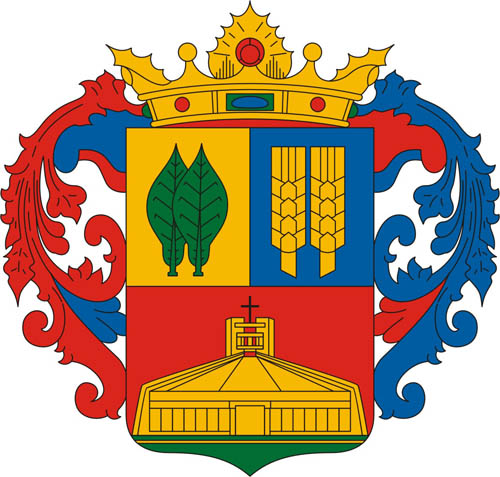
(Heves megye)
Álló, csücskös talpú vágott pajzs. A felső mező kettéosztott. A felső jobboldali aranyszínű mezőben két álló, csúcsával felfelé mutató zöld színű stilizált dohánylevél. A felső baloldali kékszínű mezőben két növekvő aranyszínű búzakalász. Az alsó vörös színű mezőben zöldszínű alapon nyugvó, sarkaival a pajzs oldalát érintő aranyszínű stilizált templom motívum. A pajzstetőn háromlombos, kétgyöngyös, aranyszínű korona, belseje vörös színű. A koronából a pajzs jobboldalán vörös színű, a baloldalán kékszínű takaró fut.
Tenk első írásos említése 1310-ből származik Thenky névalakban, de valószínűleg a település már jóval korábban is lakott volt. A török megszállás alatt szinte folyamatosan élelem- és hadianyag-szállítási útvonal volt. A hódoltság megszűnése után a Szentmáriay család birtoka lett a kiváló adottságokkal rendelkező terület. A védtelen jobbágyfalu nem vonzotta a letelepedni vágyókat, így az 1600-as évek végén Buttler János tulajdonában lévő lakatlan puszta volt. Jelentős változás az újranépesítés terén csak a XVIII. század végén történt. Az 1780-as években már 369-en éltek a településen.
A XIX. században jelentős szerepet játszottak Pusztatenk / ekkor így nevezték / életében a Csoma, a Gyulay, a Soldos és a Papp-Szász nemesi családok. A település szerkezetét meghatározták a középbirtokok és a hozzájuk kapcsolódó nemesi község pusztája, majd 1947-ben alakul Tenk önálló településsé / kb. 600 fővel /.
Az infrastruktúra fejlődésével, megépítésével / vezetékes gáz, telefon, kábel-tv, önálló orvosi körzet kialakítása, tornaterem, sportpályajátszótér, ravatalozó építés, utak portalanítása..../az itt élők életkörülményeit nagymértékben megváltoztatták, komfortosabbá tették. Megépült az új orvosi rendelő, szolgálati lakásokkal. Az épületben kapott helyet a védőnői szolgálat és a gyógyszertár is. Helyben működik a Gyöngyös-Mátra Takarékszövetkezet kihelyezett fiókja. 2000. évben elkészült az első köztéri szobor „Tenki Madonna" címmel, amely a Milleniumi Parkban kapott helyet.
Községünkben élt Blaha Lujza „a nemzet csalogánya" akinek tiszteletére emlékoszlopot állítottunk a Szent Imre Általános iskola parkjában.
A tenkiek szeretik falujukat és sokat is tesznek azért, hogy fejlődjön.
(The County of Heves)
Shield erect and party per fess, its base is curved to a point. Chief is partitioned dually. In dexter chief or two stylised tobacco leaves vert are borne, both of which are pointing upwards. In sinister chief azure two demi-ears of wheat are borne, both or. In base gules on ground vert the stylised motif of a church building is borne, or. The corners of the church building touch the sides of the shield. Tenk’s coat of arms is topped by a three-pointed verdured crown or, lined gules and decorated with two pearls. From the crown mantling is issuing, on the dexter tinctured gules and on the sinister side azure.
The first written mention of the village of Tenk goes back to the year 1310 and originally it had the form ’Thenky’, although the village had likely been inhabited prior to this date. During the Turkish Conquest of Hungary the settlement was located along the major food and munition transporting routes. After the expulsion of the Turks the village became part of the Szentmáray estate. The defenseless settlement of poor villeins was not attractive enough for new settlers, thus at the end of the 1600s, during the ownership of János Buttler, the area of the settlement got mentioned as an uninhabited place. A major change, an increase in the number of inhabitants occurred only at the end of the 18th century, when resettlement began. In the 1780s there were as many as 369 inhabitants in the village of Tenk.
In the 19th century the Csoma, Gyulay, Soldos and Papp-Szász nobiliary families played a significant role in the life of Pusztatenk, as the settlement was called in that period. The layout of the village was shaped by nearby medium-size estates and the adjacent settlement of the nobiliary. Tenk eventually became an autonomous settlement in 1947 with a population of approximately 600 people.
As infrasctucture improved (gas, telephone, cable television network, the organisation of local medical care, the construction of a sports centre, a playground, a funeral home int he village and the paving of local roads) the living conditions of the local people changed as well. A brand new health centre was opened, complete with flats for permanent medical staff. A nursing centre and a pharmacy also opened for the public in the same building. The services of the local branch of the Gyöngyös-Mátra Savings Bank are also available in the village. In the year 2000 ’The Madonna of Tenk’, the settlement’s first public statue was erected in the local Millenial Park.
Blaha Lujza, the most famous actress of Hungarian theatrical history, lovingly called ’the nightingale of the Hungarian nation’, is the village’s renowned daughter. A memorial column was erected in the park of the Saint Imre Primary School in order to pay tribute to the local celebrity.
The inhabitants of Tenk are ardent local patriots, who cherish their settlement and do everything to make it a happy and thriving village.